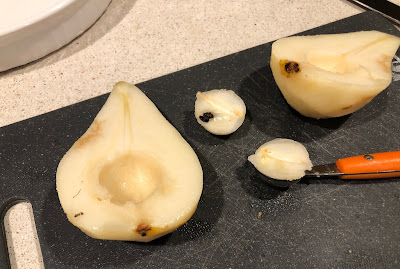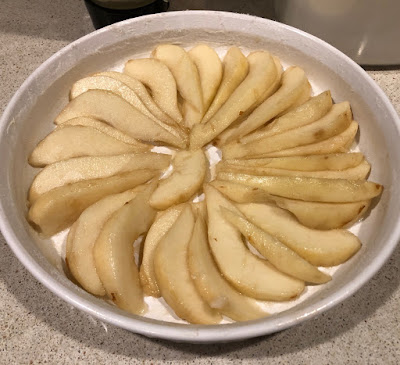
Recipe: Clafoutis puts ripe pears center stage

|
Pears come into season about the same time as apples, but seem to get lost in the early fall rush. It may be because, as some kitchen wag noted years ago, a pear is perfect for only 5 minutes. Beforehand, it's too hard, and afterwards it's mush.
A shame, really, because pears have texture and flavor that complements so many things. They go equally well with a glass of red wine, a hunk of cheese or a pile of spinach salad. They are delicious grilled, too.
While apples have cinnamon all tied up as the perfect spice accompaniment, pears have cardamom, a woefully underused spice that smells incredible in baked goods. Pears also match well with almond, so I brought all these flavors together in a quick-to-mix autumn clafoutis.
Clafoutis, if you're not familiar with it, is a French dessert that falls somewhere between custard and Dutch baby pancake, with fruit but without the latter's extreme puffiness. No crust to fuss with here, either. The batter can be made in a blender, and before you know it you have a baked treat that can serve as dessert or brunch dish.
Choose firm-ripe pears for this clafoutis. I prefer Boscs, which are more likely to stay ripe longer before turning to mush, but Bartletts are good as well. I use a 10-inch shallow ceramic tart dish for clafoutis, but a pie pan or gratin dish also will work if it's large enough. You don't want the clafoutis to be too thick; the batter should barely cover the fruit.
Autumn pear clafoutis
Serves 6 to 8

|
Ingredients:
Butter, for greasing pan
1 tablespoon granulated sugar, for dusting pan
Two large, firm-ripe pears, about 1-1/4 pounds total
1 tablespoon Amaretto or other almond liqueur, optional
Batter:
3/4 cup milk, room temperature
1/4 cup heavy cream, room temperature
3 large eggs, room temperature
1 teaspoon vanilla extract
1/4 teaspoon almond extract
1/2 cup unbleached all-purpose flour
1/3 cup granulated sugar
1/2 teaspoon ground cardamom
1/4 teaspoon salt
Powdered sugar, for serving

|
Instructions:
Heat oven to 350 degrees. Generously butter the bottom and sides of a 10-inch tart pan or other shallow baking dish, and sprinkle the 1 tablespoon of sugar over it.
Peel and core the pears and cut into 1/4-inch slices. Arrange the slices in a pleasing design on top of the sugared butter. If desired, sprinkle the pear slices with the Amaretto, and set the dish aside while you make the batter.
In the container of blender or in a large bowl (if using a mixer or immersion blender), blend together, just until combined, the milk, cream and eggs and vanilla and almond extracts. In a small bowl, stir together the flour, sugar, cardamom and salt. Add the flour mixture to the liquid mixture, and blend on medium-high speed for 1 minute.
Pour the batter over the pears in the dish carefully, to avoid disturbing the fruit pattern, and bake 40 to 45 minutes, or until the clafoutis is turning light golden brown and the tip of a knife stuck in the middle comes out clean.
Cool the clafoutis for about 10 minutes before serving, or allow to cool to room temperature. It's even good cold, but just barely warm seems to be the ideal serving temperature.
Sprinkle the clafoutis with powdered sugar before cutting and serving.
Comments
0 comments have been posted.Sacramento Digs Gardening to your inbox.
Sites We Like
Garden Checklist for week of July 21
Your garden needs you!
* Keep your vegetable garden watered, mulched and weeded. Water before 8 a.m. to reduce the chance of fungal infection and to conserve moisture.
* Feed vegetable plants bone meal, rock phosphate or other fertilizers high in phosphate to stimulate more blooms and fruiting. (But wait until daily high temperatures drop out of the 100s.)
* Don’t let tomatoes wilt or dry out completely. Give tomatoes a deep watering two to three times a week.
* Harvest vegetables promptly to encourage plants to produce more. Squash especially tends to grow rapidly in hot weather. Keep an eye on zucchini.
* Pinch back chrysanthemums for bushy plants and more flowers in September.
* Remove spent flowers from roses, daylilies and other bloomers as they finish flowering.
* Pinch off blooms from basil so the plant will grow more leaves.
* Cut back lavender after flowering to promote a second bloom.
* It's not too late to add a splash of color. Plant petunias, snapdragons, zinnias and marigolds.
* From seed, plant corn, pumpkins, radishes, winter squash and sunflowers.